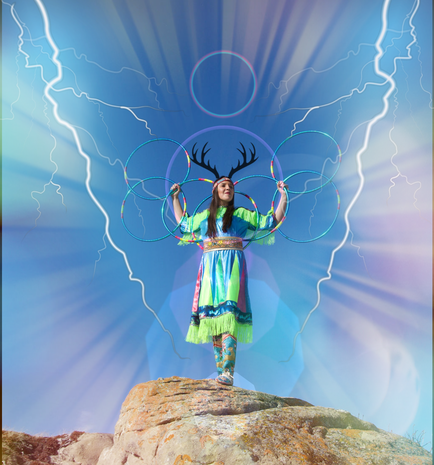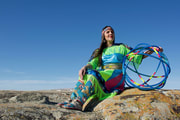|
Have you ever thought about the power of a name? I grew up in Slave Lake, Alberta, a name that comes from the Slavey people a name of European origin that is derogatory, or at best misappropriation. The name 'Slavey' refers to people who call themselves Denѐ, which translates simply to 'people'. Their are stories like this all over Turtle Island...
The name my parents gave me 'Sandra' means defender of man or helper of humanity, which is actually very appropriate if you know me. My last name Lamouche, meaning 'the fly' was given to my great grandfather because he was a hard worker, it was a nickname. Later, the missionaries told him it was because he was so insignificant, like a fly. My Blackfoot name, Itamspiakii, translates to Happy Dancing Woman and comes from the deer family. This name has many meanings- It is a reminder to be happy and think positive. It is motivation and encouragement to keep dancing, to not give up. It carries the meaning of what a woman is to Indigenous peoples, including culture carrier and life giver. The deer is a graceful and gentle creature, which I try to embody in my dance and everyday life, this also connects me to this land, and to the natural world. This name carries so much guidance, wisdom and resilience. At one time all over North America we only had our Indigenous names, which were not only spiritual and sacred, but they were also inspiring and empowering. Names could be passed on from your relatives and ancestors, with the expectation that you live up to that name and the greatness and achievements of the person who carried the name before you, as is the case with my two sons. Your name could change over your lifetime, therefore your identity could change. Through your achievements and actions could earn an appropriate name. In essence, the family or situation you were born into did not predict your path in life, you could persevere and overcome, you could change your life and your resilience was honored. The name of the first hoop dancer in the Ojibway story is 'Pukawiss' which means the disowned one, they say nobody remembers his real name. Despite being disowned Pukawiss creates the hoop dance and makes a name for himself (no pun intended) as a renowned artist, storyteller and performer. His actions speak louder than his name and his legacy remains a powerful part of Indigenous identity to this day. Indigenous names are an important part of building resilience. "Resilience is the process of adapting well in the face of adversity, trauma, tragedy, threats or significant sources of stress — such as family and relationship problems, serious health problems or workplace and financial stressors. It means "bouncing back" from difficult experiences (source)". In Canada, Indigenous peoples were systematically given European names through assimilation policies, in some cases, such as residential schools Indigenous people were sometimes given numbers to replace their names. Reclaiming Indigenous names does not only build resilience it also a step towards reconciliation. As the Truth and Reconciliation Call to Action #17 states: "We call upon all levels of government to enable residential school Survivors and their families to reclaim names changed by the residential school system by waiving administrative costs for a period of five years for the name-change process and the revision of official identity documents, such as birth certificates, passports, driver’s licenses, health cards, status cards, and social insurance numbers" Indigenous peoples are reclaiming Indigenous names all over, from personal names to community names and names of nations as an important act of reconciliation and resilience, and also an important way to take back our power as people and nations, for healing, self-determination and sovereignty.
0 Comments
 Miwasin Iskwewak Kisikaw!- Happy Women's Day! As many of you probably know today is International Women's Day! A day to recognize and celebrate the life-givers, home makers, culture carriers, water protectors, knowledge holders, ceremony keepers, earth warriors! And, so much more! My recent hoop dance at the Heard Museum 'World Championship Hoop Dance Contest' in Pheonix, Arizona was created to represent myself, as a women, who holds many of the roles mentioned above, as well as, to honor the many roles of women that go unnoticed and are undervalued in our society today. When we are in ceremony the circle is often divided into a women's side and a men's side, representing balance, equality, and unity of male and female gender roles. The hoop dance has historically been a male dominated dance, which is a critique some have towards the World Championship Hoop Dance Contest. Although, I have never heard teachings that explicitly say only men are allowed to hoop dance. I do not believe that women need a separate category at the World Championships. What I do wish to see is that women are valued, respected, and honored for what they bring to the circle. I think it is important to retain that balance, equality, and unity of different gender roles which had made our ancestors such healthy and strong people, as well as, their family, community and nations! Hiy-hiy! Thank you! Watch my World Championship Hoop Dance performance here: On December 16, 2012 I was asked to do a short hoop dance at the World Cross Country Ski Championships in Canmore, Alberta. The event would be televised around the world.
Meanwhile, a movement was happening all over Indian country and beyond, a movement sparked by a people’s continued oppression, a movement based in the cultural values and traditions of First Nations. A movement that continues to bring people together on a worldwide scale in the name of unity, peace, justice for all people, for all beings, for all of the earth. As I prepared to take the world stage for a few short minutes, I was reminded of the history of Indigenous dance that I have been researching. I thought of the early to mid- 1900’s, when our dances were made illegal in Canada and the U.S. as they were thought to be a hindrance to colonization and assimilation. Yet, during this same time, Wild West shows prevailed where dancers were put on stage to depict the colonial view of the west. Our ancestors continued to dance, whether on stage or in secret, knowing that the most important thing in the face of colonization was to continue to be ‘indian’ and continue to dance, pray, speak the language... simply being is decolonizing. For a moment I felt I understood them. I understood the need to dance, no matter what. I had a glimpse of what our ancestors went through as they battled colonization. Even in the most subtle and humble ways as simply dancing, even in Wild West shows. My heart was heavy that day with the burden of responsibilities that come with dance and knowledge. I wanted to go on stage and shout at the injustices that were being committed against our people, our land... Instead I did my hoop dance. A subtle and humble resistance. Simply being, being myself, being Nehiyaw (Cree) was an act of decolonization. This experience awakened me to something I have always known – I am my ancestors. WE are our ancestors. Not just descendants of our ancestors, but we are experiencing the same things they have experienced for years! We are fighting the same fight. We are being our ancestors, by being ourselves. As I thought of Idle No More and the goal of protecting the land I was also reminded of the signing of Treaty 8 (1899). It was the Nehiyawak who asked for a treaty after settlers had been coming into Nehiyawak territory and exploiting the land and resources without permission. I was again reminded that yes, WE ARE OUR ANCESTORS. Here we are 2013 still fighting for the same recognition, still against the exploitation of our land and resources. It’s still the same... but there is one difference. In 1899 it was 500 Nehiyawak who gathered and stopped the settlers from entering their territory until a treaty was signed... Today, thanks to technology and social media, it is millions, if not billions, of people worldwide who are gathering. When one person does a subtle and humble resistance it is indeed admirable... but when millions of people participate in the same subtle and humble resistance around the world? Not so subtle and humble anymore... This unity of people, voices and actions have created an unparalleled and far reaching transformative movement... What is now being called a Global Super-Movement. Idle No More has swept the globe being one of the top news stories a top trending hash-tag on social media. All over the world people are being awakened to the fact that WE ARE OUR ANCESTORS – WE ARE IDLE NO MORE! |
Nehiawsko Pikiskwew'Cree Woman Speaking' is a space to share my voice. My goal is to spread awareness and share wisdom as I learn and grow as a dancer, choreographer, and woman. My passion is to show the healing power of dance and culture. I love learning from elders, experience, and research and being able to synthesize Native and non-Native ways of knowing! Archives
November 2023
Categories
All
|


